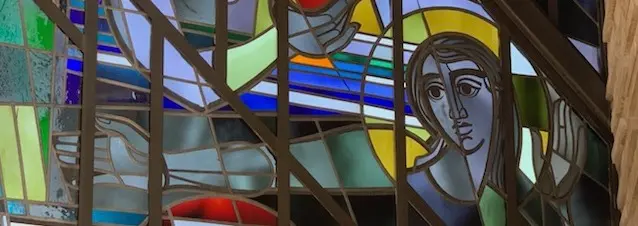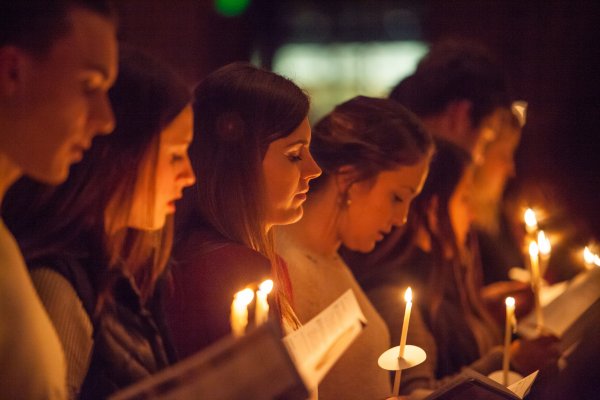Walking in the Light of Jesus’ Resurrection

The first letter of John is insistent on the real physicality of Jesus’ resurrection.
We declare to you what was from the beginning, what we have heard, what we have seen with our eyes, what we have looked at and touched with our hands, concerning the word of life [who is Jesus].
It’s an insistence that stretches the bounds of believability. After all, everyone knows that living beings, at some point, stop living and that the condition of death is irreversible. Despite significant advances in medical science, there comes a point when the breathing stops and the heart, robbed of the life-giving oxygen that it needs to deliver that same wondrous element to the rest of the body, stops beating and there can be no going back. It’s been this way all along. The crucified died of asphyxiation.
But John’s letter, written to a community of Christians decades following that first Easter, is asserting something very different:
…this life was revealed, and we have seen it and testify to it, and declare to you the eternal life that was with the Father and was revealed to us— we declare to you what we have seen and heard so that you also may have fellowship with us…
That the crucifixion of Jesus happened is an undeniable fact. John’s letter, however, is asserting that the “word of life” who he, along with others, heard, saw and touched, is eternal. Somehow it came through the brutal experience of crucifixion to stand, audible, visible and touchable, on the other side of death. For centuries, Christians have termed this phenomena “the resurrection of Jesus Christ,” and as a phenomena, it challenges everything that we think we know about our reality and how it all works.
The claim of that first Easter Sunday is not a claim of resuscitation – a reviving of life back to what it was before. We have stories of resuscitation, heroic efforts that bring a life back from the brink of death (or even the beginning experiences of death) and return that living one to their previous living state. Even Jesus’ miracles, like the raising of Lazarus, that displayed his power over death were all resuscitations like this. They were astonishing, to be sure. Lazarus’ own sisters were sure that decay had already begun to take their brother’s body. When Lazarus appeared in the opening of his own tomb, his revived body was still bound in the tight wrapping of his own mortality.
Jesus’ resurrection is different.
It’s this difference that makes it difficult.
If we had hundreds or even dozens of similar examples from human history, we could make sense of it. We could, in displays of human ingenuity, figure out how resurrection worked. Doing so would allow it to become believable by allowing us to fit it into a world and experience that we can describe and maybe even replicate.
But we don’t have that. We only have what Paul describes in his own letters as a sort of down payment on eternity – the resurrection of Jesus.
The enticement then is to try to fit the accounts of Jesus’ resurrection into the world which we know and inhabit. The draw is to make the resurrection “work” in a way that makes it sensible. To do that, we can reach for metaphor as a way of getting at a way of understanding, of incorporating that which we don’t know at all into what we do know. There’s plenty of metaphor to be had.
Life has a persistence to it. We see that persistence in the cycle of the seasons as well as our own resilience. Life often finds a way to push past that which for a time threatens to overpower it. The shoot makes its way through the crack in the concrete. Real people rise up from crushing defeat, find their footing and move on in a new direction. It’s possible to try to understand the resurrection of Jesus in these terms and in doing so, imagine that we actually have a handle on the reality of the resurrection: it’s a hope, a tenacity, a welcoming of the new day, an attending to possibility, a kind of springtime. While metaphors can serve to expand our understanding of things as they are, in this case, the metaphors threaten to constrain the incomprehensible reality of Christ’s resurrection into something we can manage for ourselves in the context of our mortal limitations.
In his poem, Seven Stanzas at Easter, the American author John Updike reveals this potential problem. His fifth stanza reads:
Let us not mock God with metaphor,
analogy, sidestepping, transcendence;
making of the event a parable, a sign painted in the
faded credulity of earlier ages:
let us walk through the door.
Updike’s poem calls us to be aware that it is possible that, in our efforts to understand and describe what exceeds our grasp, we can actually change the nature of the mystery precisely because the mystery is beyond us. John’s letter puts it this way,
…God is light and in him there is no darkness at all. If we say that we have fellowship with him while we are walking in darkness, we lie and do not do what is true; but if we walk in the light as he himself is in the light, we have fellowship with one another, and the blood of Jesus his Son cleanses us from all sin.
At first look, John appears to call us to a correct understanding of the things of God such that we would know what God seeks to teach us or do the things that God would have us do; that’s what we usually mean by “walking in the light” or “being enlightened.” But we cannot do this.
A few lines later, John’s letter makes the declaration, “If we say that we have not sinned, we make [God] a liar, and his word is not in us.” So, “walking in the light” can’t mean having one’s act together or having all of the answers – in fact it means recognizing our limitations, our mortality, and our time-bound imaginations. It means acknowledging our out-of-stepness with God, our neighbors, and ourselves. It means acknowledging our sinfulness, so we might receive Christ’s forgiveness. It means owning up to what we cannot know – like how it is possible that Christ was raised from the grave and how it is that his resurrection anticipates our own.
Peace be with you,
Pr. Jim
You can read all seven of Updike’s stanzas here.
April 14, 2021
Rev. James A. Wetzstein serves as University Pastor at Valparaiso University and takes turns writing weekly devotions.
- Archives of Devotional Writings from our Pastoral Staff
- Stinky Feet and the Love Commandment
- “HELP!”
- “Some Lent!”
- (Your vocation here) of people
- A call to courage for 2021
- A charming tale for over-achievers
- A Lesson On Beans … and Being
- A New Place
- A Point of Privilege
- A season of anticipation
- A Time of Dust
- Acquiring a peaceful spirit
- Advent = Hope
- All will be well
- Anastasis: the Greatest Story of God’s Saving Power
- Another kind of darkness
- Are we willing to cross the road for one another?
- As if we needed a reminder
- Beacons of hope
- Better Together
- Blessings As You Go
- Borderlands
- Can we learn to be happy?
- Carrying the COVID Cross
- Come and See
- Did Jesus really suffer?
- Doing without in a life of plenty
- Don’t miss this moment
- Exiles with Vision
- Fear not!
- Fear of the Lord
- Feeling at Home
- Finding Purpose in the Journey
- Finding Words for Times Like These
- Forgiving others – and ourselves
- Getting ahead with Jesus
- Getting down on Jesus’ level
- Getting through this together
- God is not overwhelmed
- Good Friday
- Grief & Graduation
- Have yourself a merry little Christmas — somehow
- Holy Week and Taking Out the Trash
- Holy Week: The aid station late in the semester
- Hopes & Dreams vs Life in the Wilderness
- How do you keep from giving up hope?
- How glad we’ll be if it’s so
- I almost slipped
- Imagining Eternity
- In a time of uncertainty, these things are certain
- In everything, grateful
- In praise of plans B … C … D …
- In the midst of grief, God will bring life
- Is there such a thing as being too forgiving?
- It’s a Three Day Weekend!
- It’s In the Bag
- It’s What’s Happening
- Jesus among us
- Killing off our future selves
- Knowing a Good Thing When We See It
- Lessons in fire building
- Let there be light!
- Let us work for real wellness in our communities
- Life Is a Highway
- Lilies and leaves and whatever else is beautiful
- Living in the Present
- Naming our demons
- O Lord, you know I hate buttermilk
- Of Fear and Failure
- On Christian Unity: When we’re not one big happy church
- On the Bucket List
- On the day after the night before
- Overwhelmed
- Persistent and Extravagant
- Pray and Let God Worry
- Praying for Reconciliation
- Preparing for the world to be turned rightside up
- Recovering from an Epic Fail
- Reformation calls for examination
- Remembering among the forgetful
- Rest
- Rest is Holy
- Right where we are
- Seeing beauty in brokenness
- Signs of Love
- Starting Small
- Still in the storm
- Surprisingly Simple: Breathe!
- Taking a Break from the Relentless
- Talking ourselves into it
- Thankfulness leads to joyfulness
- The Art of Holy Week
- The Funny Business of Forgiveness
- The Greatest of These is Love
- The Magi: Exemplars of Faith and Learning
- The Power of Small Conversations
- The Trouble with Mammon
- The Power of Taking a Sabbath
- The Spiritual Gift of Hindsight
- This can’t be done alone
- To be known
- Too.Much.
- You might be a Lutheran if…
- You will be in our prayers this summer of 2020
- Ventures of which we cannot see the ending
- WWJD? We already know
- Walking in the Light of Jesus’ Resurrection
- We had hoped
- We’re on a mission from God
- What do you do with your anger?
- What good is a shepherd?
- What is your base reality?
- What to do after you find your voice
- What to do on the day after
- What we know and what we don’t know
- When bad things happen
- When God uses something terrible for good
- When heaven & earth click
- When joy and sadness live together
- When stress overwhelms
- When the promise of resurrection is hard to believe
- When you offer up your broken cup
- When we are moved
- Where God will be found
- Where is the good shepherd carrying you?
- Wilderness Journeys
- Won’t you be my neighbor?
- Year-end time management: Keeping the main thing the main thing
- Your Valpo roots will help you grow into your future
